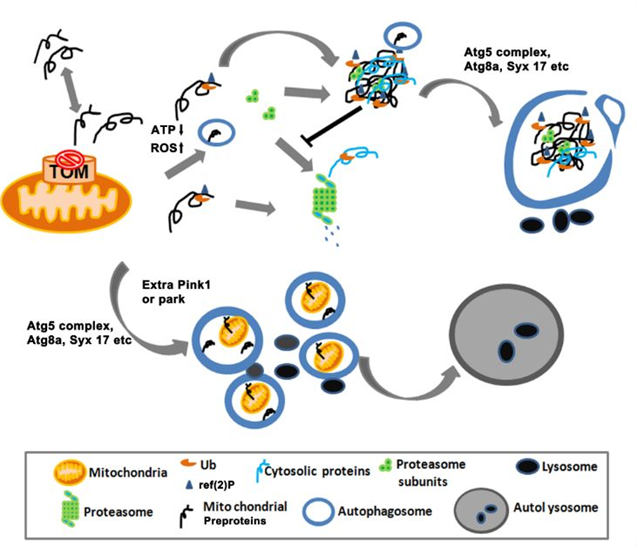Neurodegeneration is characterizedby protein aggregate deposits and mitochondrial malfunction. It is not clear whether these two phenomena are intrinsically linked or not. In an in vivo RNAi screening carried out in fruit flies, Dr. Tong’s group uncovered that the reduction of Tom40, a key subunit of the translocase of the outer mitochondrial membrane (TOM) complex, leads to imbalanced protein homeostasis in cytosol. Huge autophagosome like structureswrapping ubiquitin-positive protein aggregates were accumulated. Strikingly, the autophagosome size was ten times larger than that of the regular autophagosomes observed in the same tissue during protein starvation. In this study, they clearly demonstrate that mistargeting mitochondrial precursors led to protein aggregate formation and proteasome activity reduction.Autophagy process was induced in Tom40 RNAi tissues. However, instead of fusing with lysosomes, the small autophagosomes were recruited to the protein aggregate and fuse with each other to dump their contents to the aggregate and form a giant envelop of autophagosome membrane.They also demonstrate that increasing Pink1/Park mediated autophagy/mitophagy blocked the aggregate formation. In the fly nerve system, the reduction of Tom40 led to protein aggregate formation and neurodegeneration. Surprisingly, rather than diminishing the neurodegeneration phenotypes, the overexpression of Pink1 enhancedthe neurodegeneration phenotypes. It suggested that enhance autophagy/mitophagy in neurons with mitochondrial defects might not be an effective approach to treat degeneration.
Several polymorphisms in TOMM40, the mammalian ortholog of Tom40,has been shown to be associated with risk and age-of onset of late-onset Alzheimer’s disease. This study not only provides an explanation for the underlying mechanisms of this condition, but also presents a new angle to our understanding of neurodegeneration and mitochondrial defects.

Mr. Wei Liu, Ms. XiuyingDuan are the leading authors of this study. Dr. Tong is the corresponding author. Dr. Tong is supported by National Natural Science Foundation of China,Natural Science Foundation of Zhejiang Provinc, National Key Research & Developmental Program of China, the National Basic Research Program ofChina and Fundamental research funds for the central universities.
Link:https://www.tandfonline.com/doi/abs/10.1080/15548627.2018.1474991



